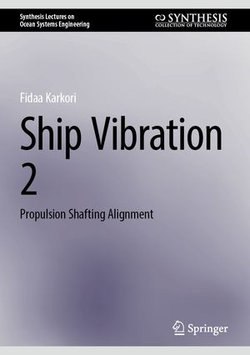
-
Books
-
Education
-
eBooks
-
Audio Books
-
Film & TV
-
Calendars, Diaries & Stationery
-
Giftshop

Working and living onboard vessels imposes a series of generally low-frequency mechanical vibrations as well as single-impulse shock loads on the human body. Also, exposure to noise is characteristic aboard vessels. Low-frequency vibrations are created by vessel motions, which are produced by the… more
Working and living onboard vessels imposes a series of generally low-frequency mechanical vibrations as well as single-impulse shock loads on the human body. Also, exposure to noise is characteristic aboard vessels. Low-frequency vibrations are created by vessel motions, which are produced by the various sea states in conjunction with vessel speed and point of sail. These motions can result in motion sickness, body instability, interruptions of task performance, sleep interruption and fatigue, increased health risk aggravated by shock loads due to slam and reduced human efficiency. Higher-frequency vibration influences comfort and is often associated with rotating machinery. The imposition of higher frequency vibrations (about 1 to 80 Hz) induces corresponding motions and forces within the human body creating discomfort and reduced human efficiency. With regard to noise, the above can similarly affect exposed humans, notably with sleep interruption and resulting fatigue, discomfort, and reduced efficiency. Also of concern are transient and permanent hearing loss, masking of audible signals, and interruption of speech communication. The concerns related to levels and characteristics of noise and vibration are covered in these two books which are related to habitability on ships and offshore structures. The purpose of this Book 2 is to provide clarification for Class Surveyors and plan review engineers to verify consistency of the survey and plan approval processes. Regarding the shaft alignment design and implementation efforts by the shipbuilding industry, this book is designed to further advance the technical approach towards shaft alignment analyses and procedures. The book is arranged to include topics on shaft alignment condition monitoring and a section dedicated to alignment problems and their solutions. Shaft alignment survey requirements are summarised in the introduction and are addressed further under a separate chapter on shaft alignment procedures and practices. Discussion on alignment calculation and measurement is expanded on to include the stern tube bearing clearance measurement. Additional clarification is provided on the application of the hull deflections, alignment optimisation, propulsion systems with no forward stern tube bearing, and reverse engineering calculations.
lessThis item is delivered digitally
Thanks for reviewing Ship Vibration 2. We will process your review. Accepted reviews will be posted within 3-7 business days.
Be the first to know, stay up to date with what's trending and get staff picks in your inbox with our newsletter


Public: Allow anyone to view or shop your List
Private: No one can view or shop your List
We have kept your A&R details for your new Angus & Robertson account
We also noticed that you have previously shopped at Bookworld. Would you like us to keep your Bookworld order history?
We also noticed that you have an account on Bookworld. Would you like us to keep your Bookworld details, including delivery addresses, order history and citizenship information?
Share This eBook